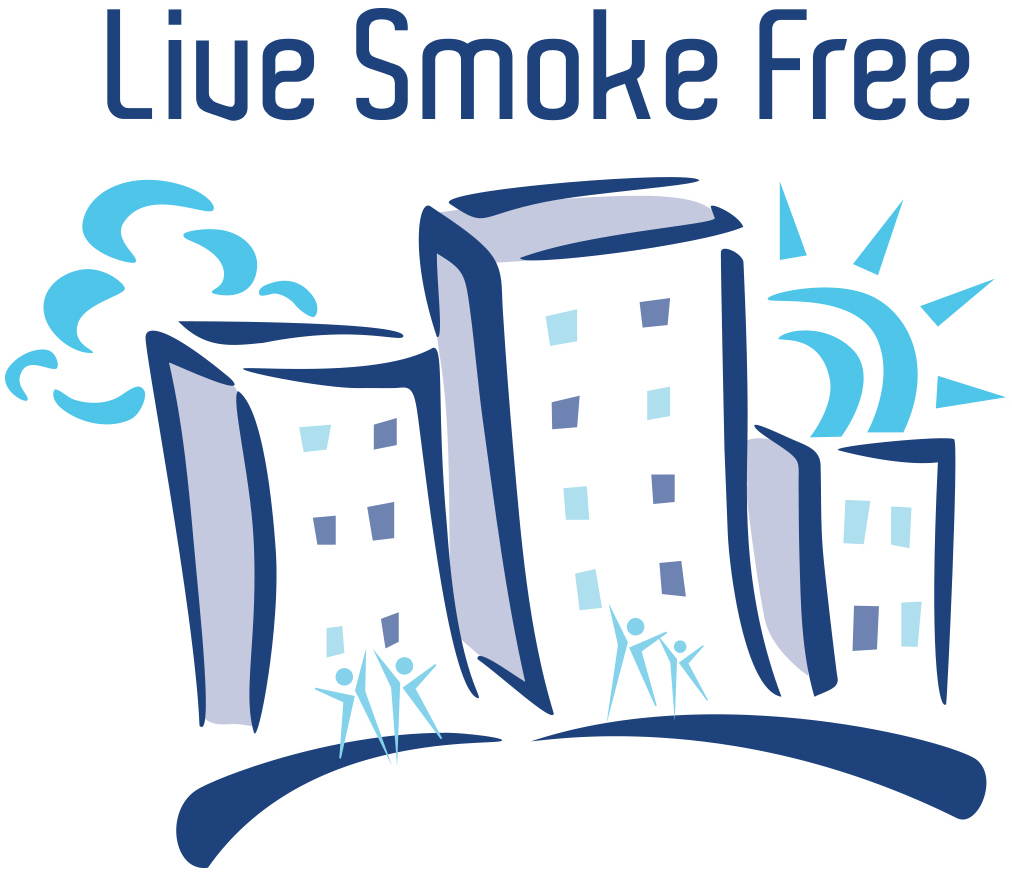TOBACCO SMOKE FACTS
What is Secondhand Smoke?
Secondhand smoke is the smoke that comes from a lit tobacco product or is exhaled by a person smoking. It contains more than 7,000 chemicals; of these chemicals, 70 are known to cause cancer and hundreds are known toxins. (1) The 2006 U.S. Surgeon General’s Report, “The Health Consequences of Involuntary Exposure to Tobacco Smoke,” concluded that there is no risk-free level of secondhand smoke, and the only way to protect people from the dangers of secondhand smoke is to eliminate the smoke exposure.(2)
The U.S. Centers for Disease Control (CDC) and the U.S. Surgeon General created a guide titled “Secondhand Smoke: What it Means to You”. This guide summarizes the 2006 Surgeon General’s Report and explains how people can take action to improve their health. The CDC and Surgeon General also created an educational poster and handout titled “Secondhand Smoke is Toxic,” to illustrate some of the chemical components in secondhand smoke.


How Does Secondhand Smoke Impact Health?
According to the CDC, 2.5 million nonsmokers have died from exposure to secondhand smoke since 1964.(1) Thousands of people in the U.S. suffer from conditions caused by or made worse by secondhand smoke. Exposure to secondhand smoke increases the risk of health problems such as:
- Heart disease, heart attacks, and increased heart rate
- Bronchitis and pneumonia
- Burning eyes and throat
- Ear Infections
- Nose bleeds
- Increased blood pressure
- Frequency and severity of asthma
- Headaches
- Sudden Infant Death Syndrome (SIDS)
- Low birth weight and pre-term babies
- Lung cancer
- Emphysema
Who Does Secondhand Smoke Harm?
Blue Cross Blue Shield found that 66,699 Minnesotans of all ages were treated for conditions such as these that were caused by secondhand smoke exposure. In 2005, 581 Minnesota infants and adults died from exposure to secondhand smoke.
People of all ages and backgrounds can be affected by secondhand smoke. Vulnerable populations, such as senior citizens and children, are at increased risk from health problems such as heart attack in seniors and asthma in children. The CDC reported that breathing in secondhand smoke has immediate harmful effects on the cardiovascular system and can increase the risk of heart attack; persons who have heart disease are extremely vulnerable.


Why is a Smoke-Free Living Environment so Important?
Secondhand smoke knows no boundaries. The CDC infographic “Going Smokefree Matters” shows how secondhand smoke travels through multi-unit buildings. The majority of Minnesota adults (86%) are nonsmokers and the majority of Minnesota households have nonsmoking residents.(4) However, residents in multi-unit buildings cannot control if they are exposed to smoke caused by their neighbors; 17% of nonsmoking Minnesotans who live in multi-housing report smelling smoke somewhere in their home(4). Smoke-free policies in multi-housing protect residents from secondhand and thirdhand smoke.
Ventilation and air purifiers cannot completely control or eliminate secondhand smoke. The Center for Energy and Environment, the American Society of Heating, Refrigerating, and Air Conditioning Engineers, and the U.S. Surgeon General all agree that the most effective way to eliminate secondhand smoke is to remove it from the building. To learn more about these experts’ reports, go to the Research page.
What is Thirdhand Smoke?
Thirdhand smoke refers to surface-clinging residual nicotine and other chemicals from tobacco smoke that can be found on indoor surfaces or persons around where smoking has taken place. Some surfaces on which thirdhand smoke can be found include hair, skin, drapes, carpet, furniture, cabinets, walls, bedding, dust, and clothing. Thirdhand smoke may pose a health hazard when the chemicals are touched, inhaled, or ingested. Exposure to thirdhand smoke can be especially harmful to children and pets who spend an increased amount of time on the floor, and/or may put things in their mouth.
Due to the fact that the many chemicals in thirdhand smoke breakdown and desorb back into the air at varying rates, the harms of thirdhand smoke can linger long past when secondhand smoke has subsided. The only way to protect residents and staff from the harms of thirdhand smoke is to ban smoking activity indoors.
If you are a renter, before you sign a lease, ask the property manager questions about second and thirdhand smoke, including if previous renters smoked in the unit.
View our thirdhand smoke FAQ or visit the Thirdhand Smoke Resource Center to learn more. The Thirdhand Smoke Resource Center, funded by California’s Tobacco-Related Disease Research Program, provides information, resources, and technical support to communities, businesses, health care professionals, and policymakers about the toxic legacy of tobacco smoke residue, and works to achieve indoor environments that are 100% free of tobacco smoke toxicants.

Citations
Research and Support
- Wilder Research. “Perceptions of Seconhand Tobacco Smoke Among Minnesota Metro Renters.” 2009. http://www.wilder.org/download.0.html?report=2273
- Center for Energy and Environment. “Survey of Minnesota Renters Regarding Secondhand Smoke Movement in Apartment Buildings and Interest in Smoke-Free Buildings.” 2001. http://mncee.org/What-We-Do/Research—Technology/
- The University of Minnesota, School of Public Health. “Survey of Ramsey County Residents Regarding The Harms of Environmental Tobacco Smoke.” 2005.
- American Society of Heating, Refridgerating & Air Conditioning Engineers. “Environmental Tobacco Smoke: Position Document.” Reaffirmed 2013.
- Tobacco Use in Minnesota: 2014 Update. Minneapolis, MN: ClearWay MinnesotaSM and Minnesota Department of Health; January 2015. http://mnadulttobaccosurvey.org/
Tobacco Smoke Facts
- U.S. Department of Health and Human Services. The Health Consequences of Smoking—50 Years of Progress: A Report of the Surgeon General. Atlanta: U.S. Department of Health and Human Services, Centers for Disease Control and Prevention, National Center for Chronic Disease Prevention and Health Promotion, Office on Smoking and Health, 2014.
- U.S. Department of Health and Human Services. “The Health Consequences of Involuntary Exposure to Tobacco Smoke: A Report of the Surgeon General.” 2006. http://www.surgeongeneral.gov/library/reports/secondhandsmoke/index.html
- BlueCross BlueShield of Minnesota. “Health Care Costs and Secondhand Smoke: The Bottom Line.” 2007.
- Tobacco Use in Minnesota: 2014 Update. Minneapolis, MN: ClearWay MinnesotaSM and Minnesota Department of Health; January 2015. http://www.mntobacco.nonprofitoffice.com/vertical/Sites/%7B988CF811-1678-459A-A9CE-34BD4C0D8B40%7D/uploads/MATS_2014_Technical_Report_Final_2015-01-21.pdf
Smoke-Free Policy Benefits
Market Advantages Section
- Center for Energy and Environment. “Survey of Minnesota Renters Regarding Secondhand Smoke Movement in Apartment Buildings and Interest in Smoke-Free Buildings.” 2001. http://mncee.org/What-We-Do/Research—Technology/
- Wilder Research. “Perceptions of Seconhand Tobacco Smoke Among Minnesota Metro Renters.” 2009. http://www.wilder.org/download.0.html?report=2273
Reduced Costs Section
- Smoke-Free Housing Project (Oregon). A program of the American Lung Association of Oregon. 2007. http://www.smokefreeoregon.com/housing
Reduced Fire Risk Section
- Tobacco Control Legal Consortium. “Regulating Cigarettes for Fire Safety.” 2007.
- U.S. Fire Administration.“Residential Smoking Fires and Causalities.” Topical Fire Research Series, Volume 5, Issue 5. 2005. http://www.usfa.dhs.gov/statistics/reports/index.shtm
- Minnesota Fire Marshal. “Fire in Minnesota .” 2009. https://dps.mn.gov/divisions/sfm/mfirs/Pages/Reporting_Statistics.aspx
- National Fire Protection Association, “The Smoking-Material Fire Problem,” 2013. http://www.nfpa.org/research/reports-and-statistics/fire-causes/smoking-materials
